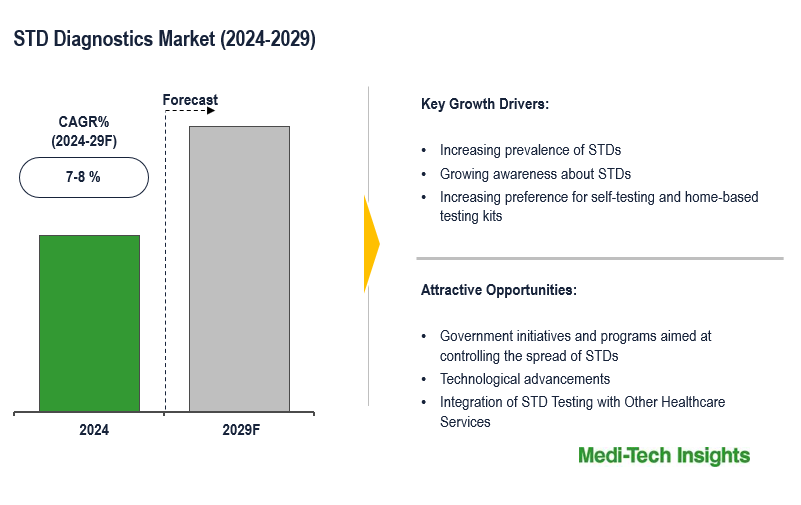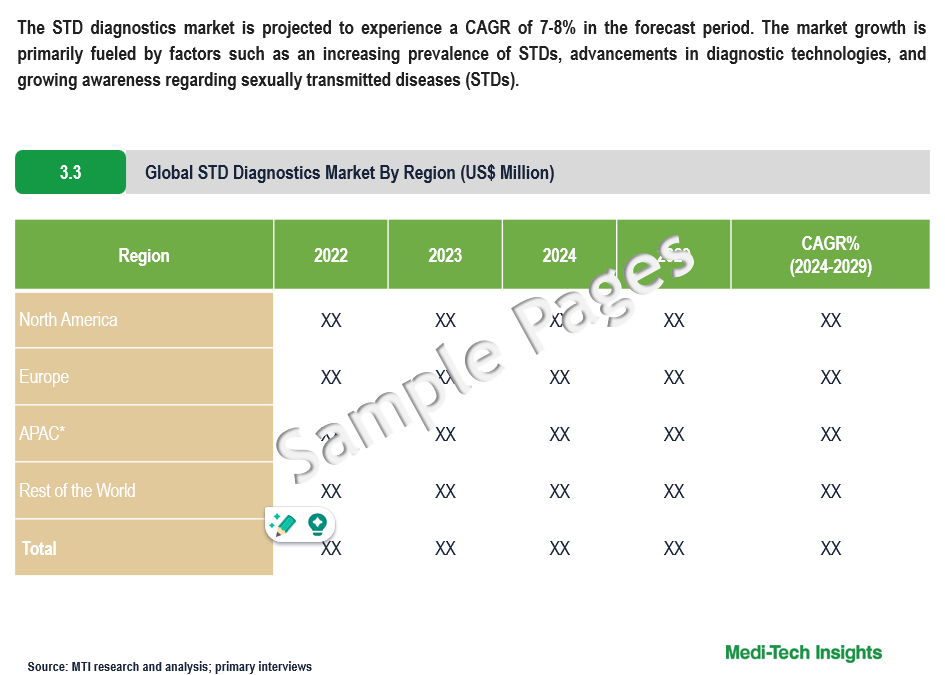
STD Diagnostics Market Size, Share, and Industry Growth Fueled by Advancements and Awareness from 2024-2029

The STD diagnostics market is projected to experience a CAGR of 7-8% in the forecast period. The market growth is primarily fueled by factors such as an increasing prevalence of STDs, advancements in diagnostic technologies, heightened awareness, and growing awareness regarding sexually transmitted diseases (STDs). To learn more about the research report, download a sample report.
Sexually Transmitted Disease (STD) Diagnostics refer to the methods and procedures used to identify and confirm the presence of sexually transmitted infections or diseases in individuals. These diagnostic tools play a crucial role in the early detection and management of STDs, contributing to effective treatment and prevention of further transmission. Some of the STD Diagnostics are classified into the following types:
- Blood Tests: Used for diagnosing infections like syphilis, HIV, and sometimes herpes. Antibodies or markers in the blood indicate the presence of certain STDs
- Urine Tests: Primarily employed to detect infections such as chlamydia and gonorrhoea. Urine samples reveal the presence of specific pathogens.
- Swab Tests: Collect samples from genital, anal, or oral areas for laboratory analysis. Commonly used for detecting chlamydia, gonorrhoea, and herpes infections.
- Molecular Diagnostics: Techniques like polymerase chain reaction (PCR) identify the genetic material of pathogens, offering high sensitivity for various STDs, including HIV and HPV
- Point-of-Care Tests: Rapid tests performed at the point of care, providing quick results without extensive laboratory analysis.
- Serological Tests: Detect antibodies in the blood, essential for identifying infections like syphilis
Overall, STD diagnostics encompass a range of tests and techniques aimed at accurately identifying sexually transmitted infections in individuals. Early detection through these diagnostic methods enables healthcare providers to initiate timely treatment and preventive measures, ultimately reducing the spread of STDs and improving public health outcomes.
Insights into Market Momentum: Drivers of STD Diagnostic Industry Growth
The STD diagnostic market is witnessing robust growth driven by several key factors. The increasing prevalence of STDs globally has increased the necessity for efficient diagnostic solutions. This rise in cases also underscores the critical need for prompt detection and treatment. There is a growing emphasis on early detection and prevention of STDs to reduce transmission rates and mitigate the risk of complications such as infertility and certain cancers. This increased awareness among individuals and healthcare providers further drives the market. Moreover, technological advancements in diagnostic techniques have revolutionized the field, providing more accurate and rapid tests, which are crucial for effective disease management. Additionally, government initiatives and education campaigns/programs aimed at controlling the spread of STDs are playing a significant role in driving the market forward by promoting screening and treatment. The rising demand for point-of-care testing and home testing kits is propelling market growth, as individuals seek convenient and accessible options for testing in the comfort of their own homes. These key drivers collectively indicate a promising trajectory for the STD diagnostic market in the forecast period. For instance,
- In December 2023, MedMira Inc. disclosed that the U.S. FDA approved its Advanced Reveal G4 Rapid HIV-1/2 Antibody Test, marking the successful acquisition of 510(k) clearance for the HIV-2 claim on the test in the US
- In May 2023, Simple HealthKit introduced an expanded at-home sexual health kit covering five common STIs in the U.S.: Chlamydia, Gonorrhea, Trichomoniasis, HIV, and Syphilis. The kit is user-friendly, accessible, inclusive, and cost-effective, providing a telehealth visit and aftercare for individuals testing positive for any of the conditions
To learn more about this report, download the PDF brochure
From Labs to Homes: Transformative Trends in STD Diagnostics
Advancements in diagnostic technologies like nucleic acid amplification tests (NAATs), and point-of-care testing have significantly enhanced the precision, sensitivity, and specificity of STD diagnostics, thereby fueling market growth through the provision of more effective and dependable testing methodologies. Moreover, the progression in molecular and immunoassay tests serves as a solid foundation for future innovations such as Next-Generation Sequencing (NGS), CRISPR-based diagnostics, multiplex immunoassays, and microfluidic technologies, promising enhanced accuracy and convenience in STD testing, thus fostering increasingly optimistic prospects for early detection, treatment, and prevention of STDs. For instance,
- In May 2022, Abbott received FDA clearance for its Alinity™ m STI Assay, a multiplex test designed to detect and differentiate four common sexually transmitted infections (STIs). Operating on the Alinity™ m system, this advanced molecular PCR platform offers fast results in high volumes, enhancing the efficiency of STI diagnostics
The escalating adoption of Point-of-Care Testing (POCT) for STD diagnostics is notable, driven by its inherent benefits such as swift results, convenience, and its suitability for diverse settings like community health clinics, outreach programs, and remote areas where laboratory facilities are scarce. Simultaneously, there's an increasing demand for home-based STD testing kits, propelled by concerns regarding privacy, convenience, and the inclination towards self-monitoring. This trend has spurred companies to intensify the development and marketing of home testing kits for various STDs, consequently broadening the market scope.
Key Constraints/Challenges
However, the anticipated growth of the STD diagnostics market during the projected timeframe may encounter impediments due to the elevated expenses linked with advanced diagnostic devices and the enforcement of rigorous regulatory measures. Additionally, the persistent social stigma surrounding clinic visits for sexual diseases is poised to pose a significant challenge to the market in the forecast period. Overcoming these obstacles will require innovative approaches and comprehensive strategies aimed at reducing costs, enhancing accessibility, and destigmatizing STD testing to ensure the sustained growth and efficacy of the market.
Regional Segmentation of the Autoimmune Disease Diagnosis Market
In North America, the prevalence of advanced diagnostic technologies is notably high, owing to well-established healthcare infrastructure and widespread awareness. Government initiatives and private sector investments further propel market growth, responding to increasing rates of STDs, particularly within specific demographics. Similarly, Europe showcases advanced healthcare systems and a robust awareness regarding STD screening and diagnosis. Although the region benefits from technological advancements, the approval processes for products may differ among individual countries due to regulations specific to each nation.
In the Asia Pacific region, rapid economic growth, escalating healthcare expenditure, and heightened awareness about STDs foster market expansion. Large population bases, notably in countries like China and India, present substantial market opportunities, with particularly high adoption of point-of-care testing in remote or underserved areas.
Competitive Landscape
Some of the key players operating in the market include Abbott Laboratories, MedMira Inc, Qaigen Inc, Cepheid (Danaher Corporation), F. Hoffmann-La Roche AG, Diasorin S.p.A, bioMeriuex, Bio-Rad Laboratories, Biocartis, DiaSorin Hologic Inc., OraSure Technologies, Inc., Qualigen Inc and Quidel Corporation among others.
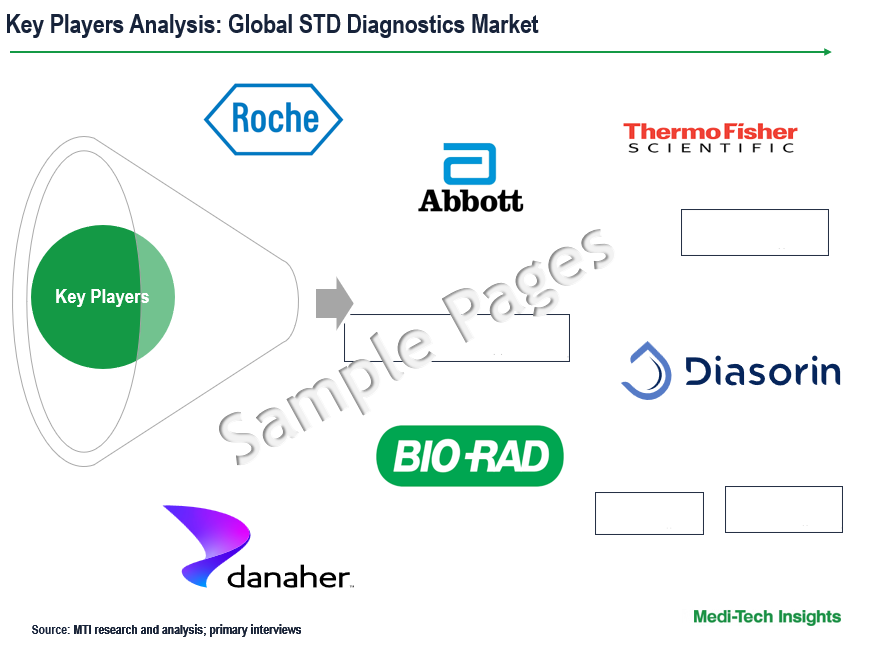
Get a Sample Report for Competitive Landscape Analysis
Organic and Inorganic Growth Strategies Adopted by Players to Establish Their Foothold in the Market
Players operating in this market are adopting both organic and inorganic growth strategies such as collaborations, and acquisitions to garner market share. For instance,
- In August 2023, The Global Fund revealed a groundbreaking agreement with generic pharmaceutical companies aimed at substantially reducing the cost of a state-of-the-art HIV medication, a development expected to have a life-saving impact. The Global Fund, established in 2002 to combat diseases like AIDS, stated that this deal would enable the provision of the advanced TLD pill at less than $45 per person annually, marking a significant milestone in access to HIV treatment.
- In December 2021, the US Centers for Disease Control and Prevention (CDC) allocated funding to nearly 30 organizations to address antimicrobial resistance (AMR) and other healthcare challenges. This initiative includes the formation of two new networks: the Global Action in Healthcare Network (GAIHN) and the Global Antimicrobial Resistance Laboratory and Response Network, aimed at combating antimicrobial resistance in diseases like gonorrhoea.
The STD diagnostics market is expected to gain momentum in the coming years due to the rising incidences of STD infections, growing awareness about STDs and the importance of early detection, technological advancements, and aggressive organic and inorganic growth strategies followed by the players.
Key Strategic Questions Addressed
-
What is the market size & forecast for the Global STD Diagnostics Market?
-
What are the historical, present, and forecasted market shares and growth rates of various segments and sub-segments of the Global STD Diagnostics Market?
-
How has COVID-19 impacted the Global STD Diagnostics Market?
-
What are the major growth drivers, restraints/challenges impacting the market?
-
What are the opportunities prevailing in the market?
-
What is the investment landscape?
-
Which region has the highest share in the global market? Which region is expected to witness the highest growth rate in the next 5 years?
-
Who are the major players operating in the market? What is the competitive positioning of key players?
-
Who are the new players entering the market?
-
What are the key strategies adopted by players?
- Research Methodology
- Secondary Research
- Primary Research
- Market Estimation
- Market Forecasting
- Executive Summary
- Market Overview
- Market Dynamics
- Drivers
- Restraints
- Opportunities
- Market Dynamics
- Global STD Diagnostics Market - Size & Forecast (2022-2029), By Disease Type
- Chlamydia
- Gonorrhoea
- Syphilis
- Genital Herpes
- Human papillomavirus (HPV)
- Other Diseases
- Global STD Diagnostics Market - Size & Forecast (2022-2029), By Device Type
- Laboratory Devices
- Point-of-Care Devices
- Global STD Diagnostics Market - Size & Forecast (2022-2029), By Test Type
- Molecular Test
- Immunology Assay Test
- Other Tests
- Global STD Diagnostics Market - Size & Forecast (2022-2029), By End User
- Hospitals
- Clinical Laboratories
- Academic & Research Institutes
- Other End Users
- Global STD Diagnostics Market - Size & Forecast (2022-2029), By Region
- North America (U.S. & Canada)
- Europe (UK, Germany, France, Italy, Spain, Rest of Europe)
- Asia Pacific (China, India, Japan, Rest of Asia Pacific)
- Rest of the World (Latin America, Middle East & Africa)
- Competitive Landscape
- Key Players and their Competitive Positioning
- Competitive Positioning of Key Players (2023)
- Offerings Assessment, By Players
- Key Strategies Assessment, By Player (2021-2023)
- New Product Launches
- Partnerships, Agreements, & Collaborations
- Mergers & Acquisitions
- Other Developments
- Key Players and their Competitive Positioning
- Key Companies Scanned (Indicative List)
- Abbott Laboratories
- MedMira Inc
- Qaigen Inc
- Cepheid (Danaher Corporation
- Hoffmann-La Roche Ltd
- Thermo-Fisher Scientific Inc.
- Hologic Inc.
- Biocartis
- bioMeriuex
- Diasorin S.p.A
- Bio-Rad Laboratories
- Qiagen
- Other Players
The study has been compiled based on extensive primary and secondary research.
Secondary Research (Indicative List)
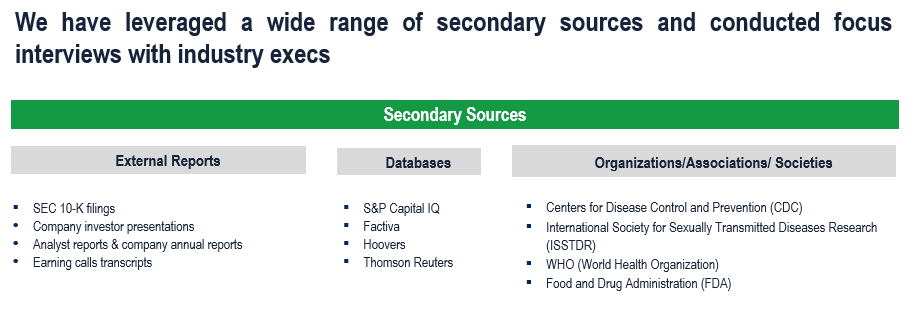
Primary Research
To validate research findings (market size & forecasts, market segmentation, market dynamics, competitive landscape, key industry trends, etc.), extensive primary interviews were conducted with both supply and demand-side stakeholders.
Supply Side Stakeholders:
- Senior Management Level: CEOs, Presidents, Vice-Presidents, Directors, Chief Technology Officers, Chief Commercial Officers
- Mid-Management Level: Product Managers, Sales Managers, Brand Managers, Business Development Managers, Consultants
Demand Side Stakeholders:
- Stakeholders in Hospitals, Clinical Laboratories, and Academic & Research Institutes among others
Breakdown of Primary Interviews
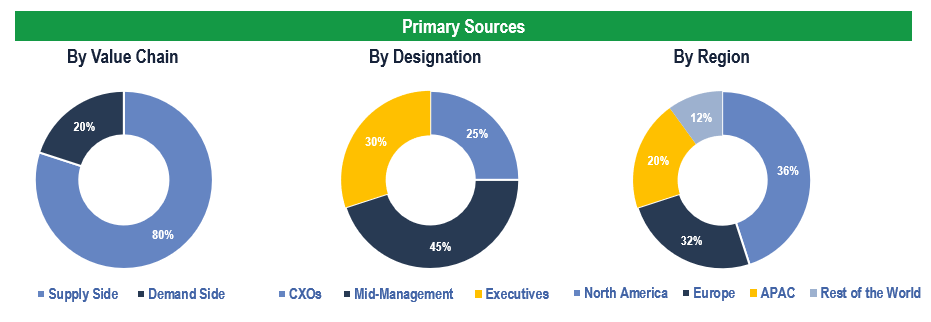
Market Size Estimation
Both ‘Top-Down and Bottom-Up Approaches’ were used to derive market size estimates and forecasts.
Data Triangulation
Research findings derived through secondary sources & internal analysis were validated with Primary Interviews, Internal Knowledge Repository, and Company Sales Data.

